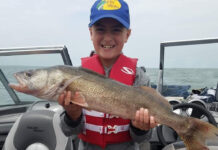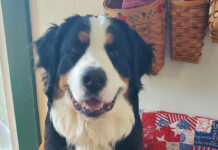Wouldn’t it be interesting to follow a few dozen wild coyotes around? You know, just to see what they eat, how they socialize, where they go, and when they do it all.
It is indeed, said Beth Wallace, a personable University of Akron graduate student who has taken coyotes to heart by devoting countless hours and a whole lot of energy as a major player in the study of these secretive animals.
The project Wallace is involved with is titled Coyote Research in Northeast Ohio and involves capturing and collaring several coyotes located in the Cuyahoga Valley National Park between Akron and Cleveland for the purpose of collecting data on the behavior, movements, and habits of coyotes.
Based on the truck load of results she shared recently with a large group of wildlife enthusiasts, the study is providing a wealth of information.
GPS collars
Let me answer a couple of questions just to relieve the anxiety suffered by those with a soft spot for coyotes. Professional trappers caught the animals using a variety of methods, none of which hurt a single animal.
And the collars secured to each coyote, a mix of radio transmitting collars and GPS equipped collars, were not permanent. All were recovered after a reasonable period of time when the collars dropped to the ground as they were designed to do.
Two kinds of critters
Now for the good stuff. According to Wallace, coyotes come in two kinds: those that live in defined territories and those which are transient.
Home bodies live in areas of about 1,500 acres while transient coyotes tend to move about in an area encompassing well over 6,000 acres, some of which cross resident territories.
Resident, or territorial packs defend their boundaries and keep house in one or more dens where they raise a litter of pups each year.
Mapping travel
Boundaries and travel patterns were documented by mapping the travel of individual coyotes. Wallace and others spend countless hours in the field mapping coyote movements in 30-minute increments. (It’s not unusual for Wallace to spend 60 hours a week on the project.)
The GPS collars store the information, which is then downloaded into computers, but the radio collars require three separate directional vectors established by receiver-equipped researchers, then crossed on a map to pinpoint the animal’s location.
Packs don’t fight
Groups, or packs, of coyotes are well established and live in relative harmony. An alpha male and alpha female breed and whelp pups while non-breeders, perhaps three or four of them, simply contribute by hunting and in other ways.
Interestingly, if the alpha male is killed, another member of the pack does not replace it. Rather, a transient male will step in. Consider it nature’s way of preventing inbreeding, Wallace suggested.
Wallace said that coyotes are monogamous and it is not unusual for an animal that loses its mate to become a nomadic loner.
About the young
Juvenile coyotes are encouraged to leave home with the arrival of a new litter and, incidentally, this year’s pups are already a few weeks old.
Young coyotes often leave for a while then return. Wallace said they may return one time or many times before striking out on their own.
Other details
Date collected from each captured coyote provided a variety of findings:
–Over a third of the coyotes collared had heartworm.
–The average weight of an adult female is 32 pounds while males average 35 pounds.
–1,700 sample of scat (poop) examined contained mostly small animal and deer remains. It appears, Wallace said, that deer, especially when fawns are on the ground, provide a major meal ticket for these opportunistic predators.
–The National Park is home to about 200 coyotes, which are also found throughout Ohio. Wallace said that the next step is to try to determine if the behaviors and movements of the coyotes in the park area are representative of those living in more rural areas of the state.
Passion for wildlife
Beth Wallace is a natural resources Intern with the Metro Parks serving Summit County. She will graduate soon with a degree in biology and passion for wildlife.
The coyote collaring study is a joint project involving several colleges.












